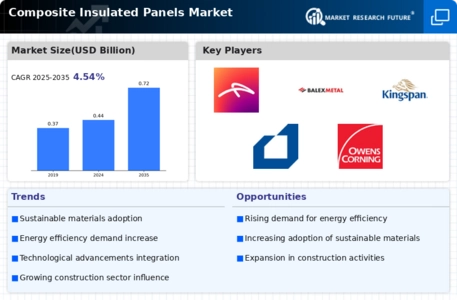Growth in Construction Activities
The Composite Insulated Panels Market is poised for growth, largely due to the expansion of construction activities across various sectors. With urbanization and infrastructure development on the rise, there is an increasing need for efficient building materials. Composite insulated panels are favored for their lightweight nature and ease of installation, which can significantly reduce construction time and labor costs. Recent statistics suggest that the construction sector is expected to witness a growth rate of around 5% annually, further propelling the demand for composite insulated panels. This growth is particularly evident in regions where rapid urban development is taking place, creating a favorable environment for the adoption of these innovative materials.
Rising Demand for Energy Efficiency
The Composite Insulated Panels Market is experiencing a notable surge in demand driven by the increasing emphasis on energy efficiency in construction. As energy costs continue to rise, builders and architects are seeking materials that offer superior insulation properties. Composite insulated panels, known for their excellent thermal performance, are becoming a preferred choice in both residential and commercial applications. According to recent data, the energy-efficient building materials segment is projected to grow at a compound annual growth rate of approximately 7% over the next five years. This trend indicates a robust market potential for composite insulated panels, as they align with the growing need for sustainable building practices and energy conservation.
Advancements in Manufacturing Technologies
The Composite Insulated Panels Market is benefiting from advancements in manufacturing technologies that enhance the quality and performance of these panels. Innovations such as improved bonding techniques and the use of high-performance materials are enabling manufacturers to produce panels that are not only more durable but also offer better insulation properties. This technological evolution is likely to attract a broader customer base, as builders and developers seek out materials that can meet stringent performance standards. Furthermore, the integration of automation in production processes is expected to reduce costs and increase efficiency, thereby making composite insulated panels more accessible to a wider market. As a result, the industry is likely to see a significant uptick in demand.
Increased Awareness of Environmental Impact
The Composite Insulated Panels Market is witnessing a shift in consumer preferences towards environmentally friendly building materials. As awareness of the environmental impact of construction practices grows, there is a marked increase in the demand for sustainable materials. Composite insulated panels, which often incorporate recycled materials and are designed for energy efficiency, align well with this trend. Market Research Future indicates that consumers are increasingly prioritizing sustainability in their purchasing decisions, which is likely to drive the adoption of composite insulated panels in various construction projects. This heightened awareness not only supports the growth of the market but also encourages manufacturers to innovate and improve the sustainability of their products.
Regulatory Incentives for Sustainable Building
The Composite Insulated Panels Market is positively influenced by regulatory incentives aimed at promoting sustainable building practices. Governments and regulatory bodies are increasingly implementing policies that encourage the use of energy-efficient materials in construction. These incentives may include tax breaks, grants, or favorable zoning laws for projects that utilize sustainable materials such as composite insulated panels. As a result, builders are more inclined to adopt these materials to comply with regulations and take advantage of financial benefits. This regulatory support is expected to bolster the market for composite insulated panels, as it not only enhances their appeal but also aligns with broader goals of reducing carbon footprints in the construction sector.


















Leave a Comment